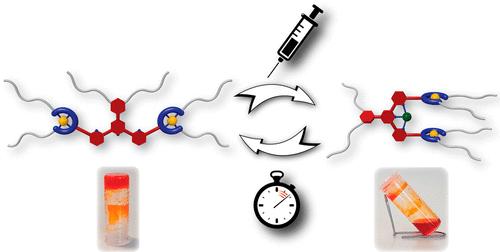通过分子镊子的机械切换实现顺序和时间可控的溶胶-凝胶转变
IF 15.6
1区 化学
Q1 CHEMISTRY, MULTIDISCIPLINARY
引用次数: 0
摘要
控制分子机器的运动以影响高阶结构在生物系统中已经建立,但对于合成类似物来说仍然是一个重大挑战。在此,我们的目标是利用可切换分子镊子的机械开关来调节其自组装并产生刺激响应的有机凝胶。我们报道了一系列具有烷基链功能化的terpy(Pt-salphen)2分子镊子,它们在开放构象中充当低分子量凝胶(lmwg)。所得的有机凝胶通过SEM, cro - tem, SAXS和流变学进行了彻底的表征。从凝胶到溶液的宏观转变是通过阳离子诱导的镊子闭合来实现的,这触发了它们的实质性结构重组。可逆的溶胶-凝胶转变是通过连续添加化学刺激或在时间控制的操作中通过可分解酸实现的。这种由化学燃料调节的瞬态分解过程能够以最小的浪费进行多次凝胶循环,同时保持稳定的流变性能。这些结果强调了可切换分子镊子在制造先进的刺激反应材料方面的潜力。本文章由计算机程序翻译,如有差异,请以英文原文为准。

Sequential and Time-Controlled Sol–Gel Transitions by Mechanical Switching of Molecular Tweezers
Controlling the motion of molecular machines to influence higher-order structures is well-established in biological systems but remains a significant challenge for synthetic analogs. Herein, we aim to harness the mechanical switching of switchable molecular tweezers to modulate their self-assembly and produce stimuli-responsive organogels. We report a series of terpy(Pt-salphen)2 molecular tweezers functionalized with alkyl chains that act as low-molecular-weight gelators (LMWGs) in their open conformation. The resulting organogels were thoroughly characterized by SEM, cryo-TEM, SAXS, and rheology. The macroscopic transition from gel to solution was achieved by the cation-induced closing of the tweezers, which triggers their substantial structural reorganization. Reversible sol–gel transitions were achieved through the sequential addition of chemical stimuli or by a decomposable acid in a time-controlled operation. Such transient disassembly process regulated by a chemical fuel enables multiple gelation cycles with minimal waste while maintaining stable rheological properties. These results underscore the potential of switchable molecular tweezers in creating advanced stimuli-responsive materials.
求助全文
通过发布文献求助,成功后即可免费获取论文全文。
去求助
来源期刊
CiteScore
24.40
自引率
6.00%
发文量
2398
审稿时长
1.6 months
期刊介绍:
The flagship journal of the American Chemical Society, known as the Journal of the American Chemical Society (JACS), has been a prestigious publication since its establishment in 1879. It holds a preeminent position in the field of chemistry and related interdisciplinary sciences. JACS is committed to disseminating cutting-edge research papers, covering a wide range of topics, and encompasses approximately 19,000 pages of Articles, Communications, and Perspectives annually. With a weekly publication frequency, JACS plays a vital role in advancing the field of chemistry by providing essential research.

 求助内容:
求助内容: 应助结果提醒方式:
应助结果提醒方式:


